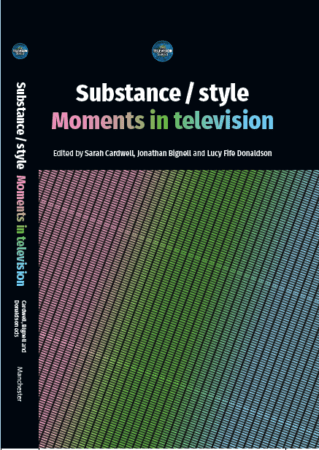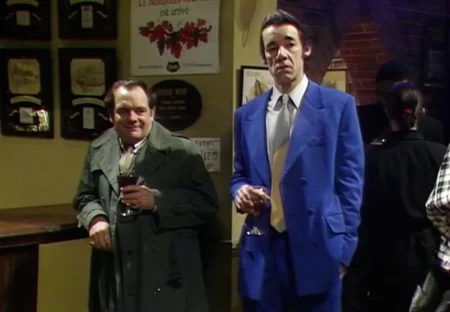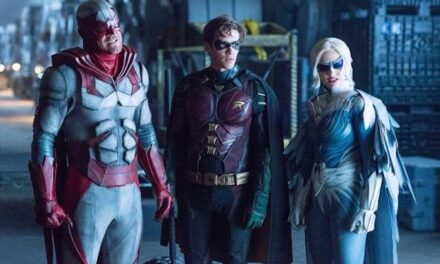I am keenly anticipating the simultaneous launch (in April) of three edited collections I have been working on with fellow editors Sarah Cardwell and Lucy Fife Donaldson. The books are part of a new sub-series from MUP, collectively titled ‘Moments in Television’. They derive from the parent ‘Television Series’ books about TV drama creators, a series that has been running for nearly 20 years. As the three new volumes, Complexity/Simplicity, Sound/Image and Substance/Style (Fig. 1) came together I was struck by how the project reorients things I said years ago about basic methodologies in TV analysis.
Programmes
Way back in 2006, in an article for the first issue of Critical Studies in Television, I wrote about how the academic study of television ‘has taken place predominantly around the analysis of programmes, … critical argument rests … on the citation of programmes as the evidence on which conclusions are based.’ (Bignell, 2006: 31) I was writing about the formation of a TV canon, and I was interested in how programme examples ‘shape theorists’ and students’ understanding, but examples are necessarily both representative and also exceptional.’ (p. 31) Each example ‘is there to represent a larger context and history, and thus performs its function by being equivalent or exchangeable with other programmes that are similar to it. Yet each must also exceed the field it stands for, and be more than typical, just because it was chosen rather than an alternative.’ (p. 31) I wanted to point out the inherent tension in exemplarity, where representativeness and selection lead in different directions; the former towards groupings of things that are similar, and the latter towards emphasising exceptionality and distinctiveness.
One passage in my argument briefly considered what some alternative objects of study might be. For example, we often look very broadly across a genre, a historical period, a mode of storytelling or the work of an individual creator. But there too, overarching arguments depend on readings of programmes. In Film Studies, moments have been a focus for a while, exemplified by Tom Brown and James Walters’ collection Film Moments. In 2006 I briefly introduced the idea of looking at tiny pieces of TV instead of whole programmes, though I quickly dismissed the idea: ‘It is hard to imagine a book called Fifty Key Television Extracts that might sensibly rival the useful discussions collected in Glen Creeber’s [2004] volume that addresses fifty programmes.’ (p. 32) I did note that back in the early 1980s in a discussion of the concept of ‘flow,’ John Ellis (1982: 112) had argued that the basic unit of television is not the programme but the segment: ‘small sequential unities of images and sounds whose maximum duration seems to be about five minutes.’ This important insight explains channel surfing, jumping from a segment on one channel to a segment somewhere else, and the industry’s interest in minute-by-minute audience ratings. It also explains the lists repeatedly made of the nation’s favourite TV moments (like Fig. 2). But within the academy, a focus on the segment as such has not been very important except as a way of talking about the larger unit of the programme. It is programmes you put on your course schedule, even if you only discuss a few segments from them in your seminar.
Moments
In the Moments in Television books, it’s true that our contributors engage closely with short moments so they can argue for a programme’s achievements and persuade the reader of its significance. But the moment is the starting-point and the inspiration, not the proof of an argument they already have in place. The idea of ‘moment’ includes close analysis of TV aesthetics, and aims to suggest detailed, evidence-based argument. ‘Moment’ also has the meaning, drawn from physics, of an impactful turning-force that shifts a text or a viewer in a new direction. The word also has an evaluative meaning when a programme is argued to be representative of a moment in time, a tendency or an innovation. ‘Moment’ welds the methodology of close analysis onto arguments for aesthetic achievement or historical importance, or both. We focused each Moments volume around binary terms that have multiple resonances. Often the binary carries an implicit valuation, so that in our first three books the title terms reflect the common prioritisation of Image, Complexity and Substance over the lesser Sound, Simplicity and Style. The chapters each wrestle in different ways with those hierarchies and distinctions, trying to shed new light on existing ways of thinking about TV.
The underlying premise of the Moments series comes from TV Aesthetics, the philosophically inclined methodology that thinks of TV as an art more than as a medium. The evaluative and appreciative mood of the books comes from this art-historical approach, more than from the semiotic, textual approaches I have adopted for years. But I realised last week that I first encountered aesthetic theory and the idea of the moment even longer ago, when I was an undergraduate. Back in 1983 my seminar group was analysing the final part of Walter Pater’s art-historical study, The Renaissance, written in 1868. Its ‘Conclusion’ is a justly famous passage that was influential on the literary and artistic movements, around the start of the 20th century, that later became known as Modernism. Pater withheld his ‘Conclusion’ from early editions of his book because of his anxiety that it might lead young people into a solipsistic, febrile kind of self-absorption. The feelings that aesthetic experience might prompt have a seductive beauty but also an evanescence that is inevitably melancholy: ‘Not to discriminate every moment some passionate attitude in those about us, and in the very brilliancy of their gifts some tragic dividing of forces on their ways, is, on this short day of frost and sun, to sleep before evening.’ (Pater, 1868: 237)
As things began to fall apart and the centre could not hold, Pater was keen to focus on the value that could be plucked from everyday experiences and people around us: ‘While all melts under our feet, we may well grasp at any exquisite passion, or any contribution to knowledge that seems by a lifted horizon to set the spirit free for a moment’ (p. 237). This affective aesthetic connection needed an observer tuned-into its power, unencumbered by prior theories and open to new experiences: ‘we shall hardly have time to make theories about the things we see and touch. What we have to do is to be for ever curiously testing new opinions and courting new impressions’. The sense of time experienced as a flow, punctuated by moments when temporary conjunctions of things spark a sudden sense of insight and pleasure, and the need to seize these moments and communicate their value, are key to this view. In somewhat of an echo of The Renaissance’s argument about the value of art and the value of experiencing moments in everyday life as if they were art, the Moments series makes a case for the art of television.
Jonathan Bignell is Professor of Television and Film at the University of Reading. He is a General Editor, with Sarah Cardwell and Lucy Fife Donaldson, of MUP’s ‘Television Series’. Jonathan works on histories of television drama, cinema and children’s media. Some of his work is available free online from his university web page or from his academia.edu page.
References
Bignell, J., (2006), ‘Programmes and Canons’, Critical Studies in Television, 1:1, 31-36. https://doi.org/10.7227/CST.1.1.6
Brown, Tom and James Walters (eds) (2010), Film Moments: Criticism, History, Theory. London: BFI.
Cardwell, S., J. Bignell and L. Donaldson (eds) (2022), Sound/Image: Moments in Television. Manchester: Manchester University Press.
Cardwell, S., J. Bignell and L. Donaldson (eds) (2022), Substance/Style: Moments in Television. Manchester: Manchester University Press.
Cardwell, S., J. Bignell and L. Donaldson (eds) (2022), Complexity/Simplicity: Moments in Television. Manchester: Manchester University Press.
Creeber, G. (ed.) (2004), Fifty Key Television Programmes. London: Arnold.
Ellis, J. (1982), Visible Fictions: Cinema, Television, Video. London: Routledge & Kegan Paul.
Pater, W. (1868), The Renaissance: Studies in Art and Poetry. Available at https://gutenberg.org › files › 2398 › 2398-h › 2398-h.htm






